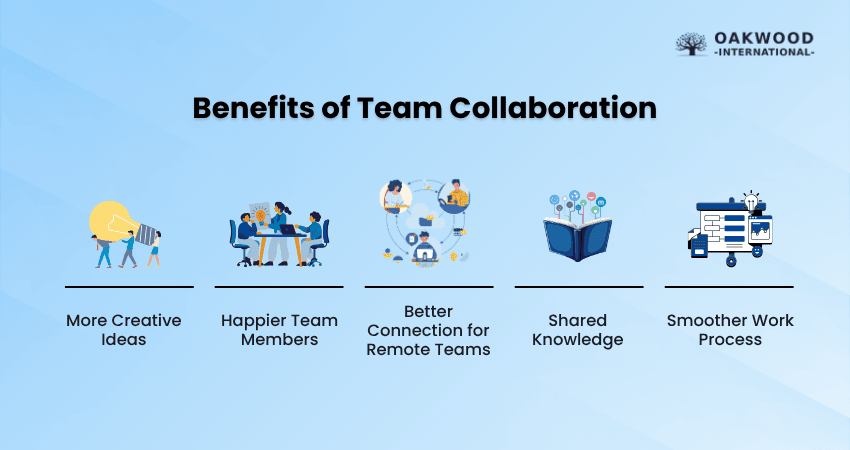Table of Contents


No matter how simple or complex a project, there's one vital ingredient to tasting assured success: Team Collaboration. It's the spark that turns individual efforts into brilliant results. It's the synergy of minds syncing, sharing and building together to achieve something greater. As the world becomes more digitally interconnected, such collaboration becomes easier to harness as it drives the DNA of every workflow.
But what exactly is Team Collaboration, and why does it serve as the lifeline of successful teams? In this blog, we’ll dive into its meaning, importance and game-changing benefits that every modern workplace needs to thrive. So read on and transform the way your team works and wins together.
Table of Contents
What is Team Collaboration?
Elements of Successful Team Collaboration
Seven Ways to Collaborate With the Team
Benefits of Team Collaboration
Challenges of Team Collaboration
Tips to Improve Team Collaboration
Must-have Tools for Team Collaboration
Conclusion
What is Team Collaboration?
Team Collaboration is a communication approach that involves working together as a group to share ideas, solve problems, and reach goals. It’s about open communication, teamwork, and equal involvement from everyone. The main aim is to finish tasks faster, find creative solutions together, and ensure everyone feels valued and proud of their work.
There are many ways to build and improve Team Collaboration, but some proven practices stand out. Once a team is formed, members must take time to get to know each other by learning about each person’s background, skills, strengths, and role. Team-building activities are a great way to encourage early cooperation and build a High Performing Team.
Elements of Successful Team Collaboration
Here are the key elements of successful Team Collaboration that’s guaranteed to drive long term triumph for your projects
1. Communication
This includes providing clear instructions, asking questions when something is unclear, and actively listening to everyone on the team. A good way to drive communication is by using a team messaging tool, which lets members share files, make video calls and send real-time updates.
2. Transparency
In addition to maintaining open communication, it’s essential to be transparent. This involves setting goals, clearly outlining each person’s role from the outset, and keeping the team informed if any issues arise.
3. Employee Engagement
Engaged team members are more motivated and collaborative. Recognising each person’s strengths and encouraging their contributions not only boosts collaboration but also supports overall Employee Wellbeing.
4. Compromise
When disagreements happen, team members must be ready to find common ground for the greater good of the group. Having team members with a positive mindset and a willingness to compromise helps everyone work more effectively together, amplifying the team’s overall success.
5. Conflict Management
Strong Team Collaboration is not a guarantee that conflicts won't occur. So, it’s important to have a plan in place to manage them. These issues can be addressed one-on-one with the Team Leader or discussed openly in a group setting.
6. Reliability
Once the duties and goals are identified for each team member, it's the job of the entire team to hold each other accountable. Team Collaboration will fail if certain team members fall short of their expectations and require others to compensate for their shortcomings.
7. Diversity
A team made up of people with different skills, knowledge, and viewpoints encourages a more well-rounded approach to collaboration. This diversity helps the team see challenges from multiple angles and come up with more creative solutions.
Step into leadership with ILM Level 2 Training to build confidence, clarity, and core skills.
Seven Ways to Collaborate With the Team
Working well with your team helps everyone accomplish more and feel satisfied with their work. Here are the seven easy ways to team up better, share ideas and reach your goals together.
1. Establish a Common Goal
Establish a common goal that all team members can work toward.
A shared goal allows everyone to understand the company’s objectives and plans.
It enables team members to manage their time more effectively.
A clear goal keeps conversations and workflows focused on solving problems and generating ideas.
It helps you make sure that everyone stays on track during the collaboration process.
2. Design a Clear Workflow
Collaboration involves multiple people working together simultaneously.
Setting up a workflow helps simplify the collaboration process.
A straightforward workflow keeps the team focused and improves communication.
It lets team members understand their own deadlines and those of others.
Workflows also provide employees with insight into various aspects of the project.
3. Identify Strengths
As a Team Leader, you must understand the strengths of each team member.
Assign roles that allow individuals to harness their strengths effectively.
Recognise and highlight team members’ skills to benefit the whole project.
Utilise real-life strengths in relevant tasks, such as involving a customer-focused person in service strategy discussions.
Remember that a strong team always includes a mix of diverse talents and abilities.
4. Be an Example
As a Team Leader, you must set a strong example of collaborative behaviour.
After all, team members often mirror the environment created by their leader.
You must show openness to new suggestions and ideas from the team.
Encourage team members to try out new skills or offer fresh input.
Promote a culture that values expanding the team’s skill set.
5. Consider Incorporating Technology
Technology plays a big role in organising and supporting collaboration, especially for remote teams.
Messaging services, such as instant messaging, email and automation tools, can help keep the communication process clear and timely.
Video conferencing enables team members in different locations to connect and build stronger relationships. It also enables recording meetings for future reference or review.
Digital calendars help coordinate timelines and track deadlines in a single, shared space.
Workflow Management Software (WMS) visually maps out the project’s progress, ensuring everyone stays aligned.

6. Encourage Honesty
You must create a space where team members are comfortable sharing their time limits and capabilities in an honest manner.
Honesty helps address challenges early and allows for better task assignments.
An open environment builds confidence among the team members to share new ideas.
Team members must communicate deadline changes and understand their impact on others.
Being honest about difficulties allows the team to offer support and solutions.
Become a leader that every team looks up to with our ILM Level 2 Certificate in Leadership and Team Skills - Sign up now and lead with confidence!
7. Analyse Your Company Culture
Company culture plays a substantial role in determining how effectively your team collaborates.
Employee’s feelings about their team and workload have a big impact on their morale and productivity.
Trust and respect among team members can result in stronger working relationships.
Your team can benefit from diverse skills and experiences when collaboration is encouraged.
A positive work environment is the key to boosting commitment towards tasks.
Benefits of Team Collaboration
Here are the benefits of Team Collaboration:

- More Creative Ideas: When a team works together, they come up with fresh ideas and smart solutions that may not happen when working alone. Team brainstorming helps build on each other’s thoughts for greater results.
- Happier Team Members: Working together makes people feel more involved and valued. It cultivates stronger connections and improves team spirit, resulting in better quality work and long-term success.
- Better Connection for Remote Teams: Teams working from different places can still collaborate well using tools like messaging apps, project trackers, and video calls. These tools help everyone stay in touch and make group decisions.
- Shared Knowledge: Teamwork enables people to share their knowledge, ensuring that no important information is lost. A clear and open way of working keeps everyone on the same page.
- Smoother Work Process: A team that works well together gets things done faster and more efficiently. Using collaboration tools can help organise tasks, avoid delays, and focus on what matters most.
Challenges of Team Collaboration
Working well as a team can be challenging, but being aware of what to expect can make things easier. Here are seven common issues associated with Team Collaboration and how to handle them:
- Slow to Adapt: Some team members may be unsure about using new tools or ways of working. Start small and let experienced team members guide the rest.
- Not Everyone Speaks up: Quieter individuals might struggle to share their thoughts. Establish meeting rules that welcome all voices and remind everyone that making mistakes is a natural part of growth.
- Too Many Alerts: Constant notifications can be distracting. Therefore, the app settings must be adjusted to minimise alerts and help your team stay focused.
- Scattered Information: When files and updates are spread out, it's hard to stay organised. That's why one platform to keep everything in one place is the go-to option.
- Slow Decisions: Bigger teams mean more opinions, which can delay choices. You must give clear decision-making roles to keep things moving.
- Personality Clashes: Strong voices can cause conflict. You must build a balanced team with diverse skills and check in frequently to maintain smooth operations.
- Slow Progress: Teamwork takes time. So set clear goals early so everyone knows what to aim for and how to stay on track.
Inspire your team to not just meet deadlines but thrive and make lasting impressions! Our ILM Level 2 Award in Leadership and Team Skills Course will help you out - Sign up now!
Tips to Improve Team Collaboration
As established, good teamwork makes everything easier and more fun. If your team works well together, you can solve problems faster and get better results. Here are some proven tips to improve Team Collaboration:
1. Provide Clear Expectations
It’s essential to set clear expectations for the employees’ performance. This helps them understand their exact responsibilities on a project and which team members to consult for advice.
2. Schedule Regular Meetings
Having frequent discussions is the ideal way for team members to communicate and exchange their ideas at regular intervals. You can opt for weekly or monthly team meetings, depending on the projects and time restraints.
3. Offer Feedback
Team members sharing both positive and negative feedback can help individuals improve skills and recognise areas of improvement. Recognising the team’s overall successes can also increase employee morale.
4. Engage in Team-building Activities
Team-building exercises are essential because they help employees become better acquainted with each other in a more relaxed environment. These activities can be organised either in person or online, depending on whether your team works remotely.
Must-have Tools for Team Collaboration
Team Collaboration software makes it easier for your team to communicate, share files, and manage tasks. Here are some useful tools that support effective teamwork:
1. File Sharing Tools
Searching for documents or waiting for emails can slow things down. Tools like Google Workspace, Microsoft Office or Dropbox provide your team with a shared space for storing and accessing files easily.
2. Communication Tools
Quick and easy communication helps teams stay connected, especially for simple updates or team bonding. Tools like Slack or Microsoft Teams keep everyone in touch, which is especially helpful for remote teams.

3. Video Collaboration Tools
For teams working remotely, video calls using tools like Zoom or Google Meet help build stronger connections. Make sure everyone can create and join calls and understands how to use the platform.
4. Work Management Platform
Tools like Asana help teams stay organised, track progress, and understand goals. These platforms make it easier to see what everyone’s working on and keep projects running smoothly.
Conclusion
Team Collaboration is the heartbeat of a successful, forward-thinking workplace. This is because it blends ideas, builds trust and sparks innovation, and when teams truly work together, they exceed their goals. So, let teamwork lead the way to brighter, bolder achievements and a space where everyone contributes, learns and thrives.
Looking for your edge in the world of leadership? Our ILM Level 3 Diploma in Leadership and Management will show you the way – register now!


 Back
Back



 Back to Catagories
Back to Catagories





 + 44 7452 122728
+ 44 7452 122728










